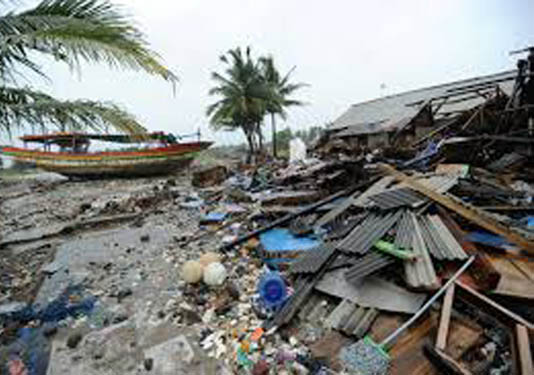CARITA, Indonesia, Dec 26, 2018 (BSS/AFP) – Indonesian search and rescue
teams Wednesday plucked stranded residents from remote islands and pushed
into isolated communities desperate for aid in the aftermath of a volcano-
triggered tsunami that killed over 400.
But torrential rains hampered the effort and heaped more misery on the
region, as officials warned another killer wave could hit the stricken area.
The disaster agency cautioned residents to stay clear of the coast, as
fresh activity at the Anak Krakatoa volcano, which sits in the middle of the
Sunda Strait between Java and Sumatra islands, threatened to spark another
tsunami.
A section of the crater — which emerged at the site of the legendary
Krakatoa volcano, whose massive 1883 eruption killed at least 36,000 people –
– collapsed after an eruption and slid into the ocean, triggering Saturday
night’s killer wave.
It struck without warning, washing over popular beaches and inundating
tourist hotels and coastal communities, leaving a trail of death and
destruction in its wake.
The disaster agency slightly raised the death toll Wednesday to 430, with
1,495 people injured and another 159 missing.
“There’s a chance the number of fatalities will rise,” agency spokesman
Sutopo Purwo Nugroho told a press briefing.
Medical workers have warned that clean water and medicine supplies were
running low — stoking fears of a public health crisis — as thousands of
displaced survivors cram shelters and hospitals.
Many were left homeless by the killer wave, and fear going back to their
communities.
“I’m here because people said there could another tsunami,” Etin Supriatin
said from an evacuation centre in shattered Labuan.
– ‘No reason to stay’ –
The disaster agency dispatched helicopters to drop supplies into hard-to-
reach communities, while hundreds of residents on tiny islands in the Sunda
Strait were airlifted or taken by boat to shelters.
“We tried to stay because it’s our island, but after a while we got
scared,” said Sariyah, a 45-year-old resident of tiny Sebesi island, who
evacuated to the mainland on a boat.
“My house has been destroyed so there’s no more reason to stay.”
Sniffer dogs are being used to find those still missing as grief-stricken
relatives lined up at identification centres.
But hopes of finding any survivors beneath the rubble have dwindled.
Tubagus Cecep, 63, waited nervously at the area’s main identification
centre to see if a body was that of his missing son.
“I’m scared my son is dead, but if I keep my faith in God maybe he could
have been swept away somewhere and is still alive,” he said.
At the Tanjung Lesung resort, cars and minibuses had been thrown against
buildings, concrete walls cracked into small pieces and uprooted trees spread
around. A wooden sign that read “Good Times” lay on the ground.
The tsunami struck the resort as more than 200 workers from the state
electricity company were watching pop band “Seventeen” perform.
The four-member group was hurled from the stage as the water slammed into
the audience — only the band’s lead vocalist survived.
The tsunami was Indonesia’s third major natural disaster in six months,
following a series of powerful earthquakes on the island of Lombok in July
and August and a quake-tsunami in September that killed around 2,200 people
in Palu on Sulawesi island, with thousands more missing and presumed dead.
On Wednesday, thousands prayed for loved ones at mass graves and mosques to
mark the 14th anniversary of the 2004 Boxing Day tsunami, which killed some
220,000 people in countries around the Indian Ocean.
Indonesia, a vast Southeast Asian archipelago, is one of the most disaster-
hit nations on Earth due to its position straddling the so-called Pacific
Ring of Fire, where tectonic plates collide.



